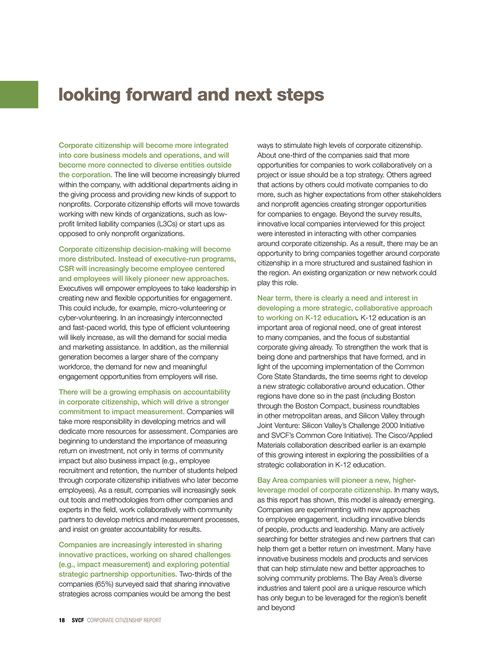
looking forward and next steps
Corporate citizenship will become more integrated into core business models and operations, and will become more connected to diverse entities outside the corporation. The line will become increasingly blurred within the company, with additional departments aiding in the giving process and providing new kinds of support to nonprofits. Corporate citizenship efforts will move towards working with new kinds of organizations, such as lowprofit limited liability companies (L3Cs) or start ups as opposed to only nonprofit organizations. Corporate citizenship decision-making will become more distributed. Instead of executive-run programs, CSR will increasingly become employee centered and employees will likely pioneer new approaches. Executives will empower employees to take leadership in creating new and flexible opportunities for engagement. This could include, for example, micro-volunteering or cyber-volunteering. In an increasingly interconnected and fast-paced world, this type of efficient volunteering will likely increase, as will the demand for social media and marketing assistance. In addition, as the millennial generation becomes a larger share of the company workforce, the demand for new and meaningful engagement opportunities from employers will rise. There will be a growing emphasis on accountability in corporate citizenship, which will drive a stronger commitment to impact measurement. Companies will take more responsibility in developing metrics and will dedicate more resources for assessment. Companies are beginning to understand the importance of measuring return on investment, not only in terms of community impact but also business impact (e.g., employee recruitment and retention, the number of students helped through corporate citizenship initiatives who later become employees). As a result, companies will increasingly seek out tools and methodologies from other companies and experts in the field, work collaboratively with community partners to develop metrics and measurement processes, and insist on greater accountability for results. Companies are increasingly interested in sharing innovative practices, working on shared challenges (e.g., impact measurement) and exploring potential strategic partnership opportunities. Two-thirds of the companies (65%) surveyed said that sharing innovative strategies across companies would be among the best ways to stimulate high levels of corporate citizenship. About one-third of the companies said that more opportunities for companies to work collaboratively on a project or issue should be a top strategy. Others agreed that actions by others could motivate companies to do more, such as higher expectations from other stakeholders and nonprofit agencies creating stronger opportunities for companies to engage. Beyond the survey results, innovative local companies interviewed for this project were interested in interacting with other companies around corporate citizenship. As a result, there may be an opportunity to bring companies together around corporate citizenship in a more structured and sustained fashion in the region. An existing organization or new network could play this role. Near term, there is clearly a need and interest in developing a more strategic, collaborative approach to working on K-12 education. K-12 education is an important area of regional need, one of great interest to many companies, and the focus of substantial corporate giving already. To strengthen the work that is being done and partnerships that have formed, and in light of the upcoming implementation of the Common Core State Standards, the time seems right to develop a new strategic collaborative around education. Other regions have done so in the past (including Boston through the Boston Compact, business roundtables in other metropolitan areas, and Silicon Valley through Joint Venture: Silicon Valley’s Challenge 2000 Initiative and SVCF’s Common Core Initiative). The Cisco/Applied Materials collaboration described earlier is an example of this growing interest in exploring the possibilities of a strategic collaboration in K-12 education. Bay Area companies will pioneer a new, higherleverage model of corporate citizenship. In many ways, as this report has shown, this model is already emerging. Companies are experimenting with new approaches to employee engagement, including innovative blends of people, products and leadership. Many are actively searching for better strategies and new partners that can help them get a better return on investment. Many have innovative business models and products and services that can help stimulate new and better approaches to solving community problems. The Bay Area’s diverse industries and talent pool are a unique resource which has only begun to be leveraged for the region’s benefit and beyond
“Bay Area companies will pioneer a new, higher-leverage model of corporate citizenship. In many ways, as this report has shown, this model is already emerging.”
Bay Area: Stimulating Corporate Citizenship
What would best stimulate high levels of corporate citizenship in the Bay Area?
Mentoring opportunities matching longstanding corporate citizens with newer Sharing innovative corporate citizenship strategies across companies
Other
Nonprofit organizations creatingstronger opportunities for companies to engage
12%
6%
29%
65%
41%
Senior executives encouraging one another to do more
Expectations from government, employees or other key stakeholders
35% 35%
Opportunities for companies to work collaboratively on a project or issue
18
SVCF CORPORATE CITIZENSHIP REPORT
SVCF CORPORATE CITIZENSHIP REPORT
19